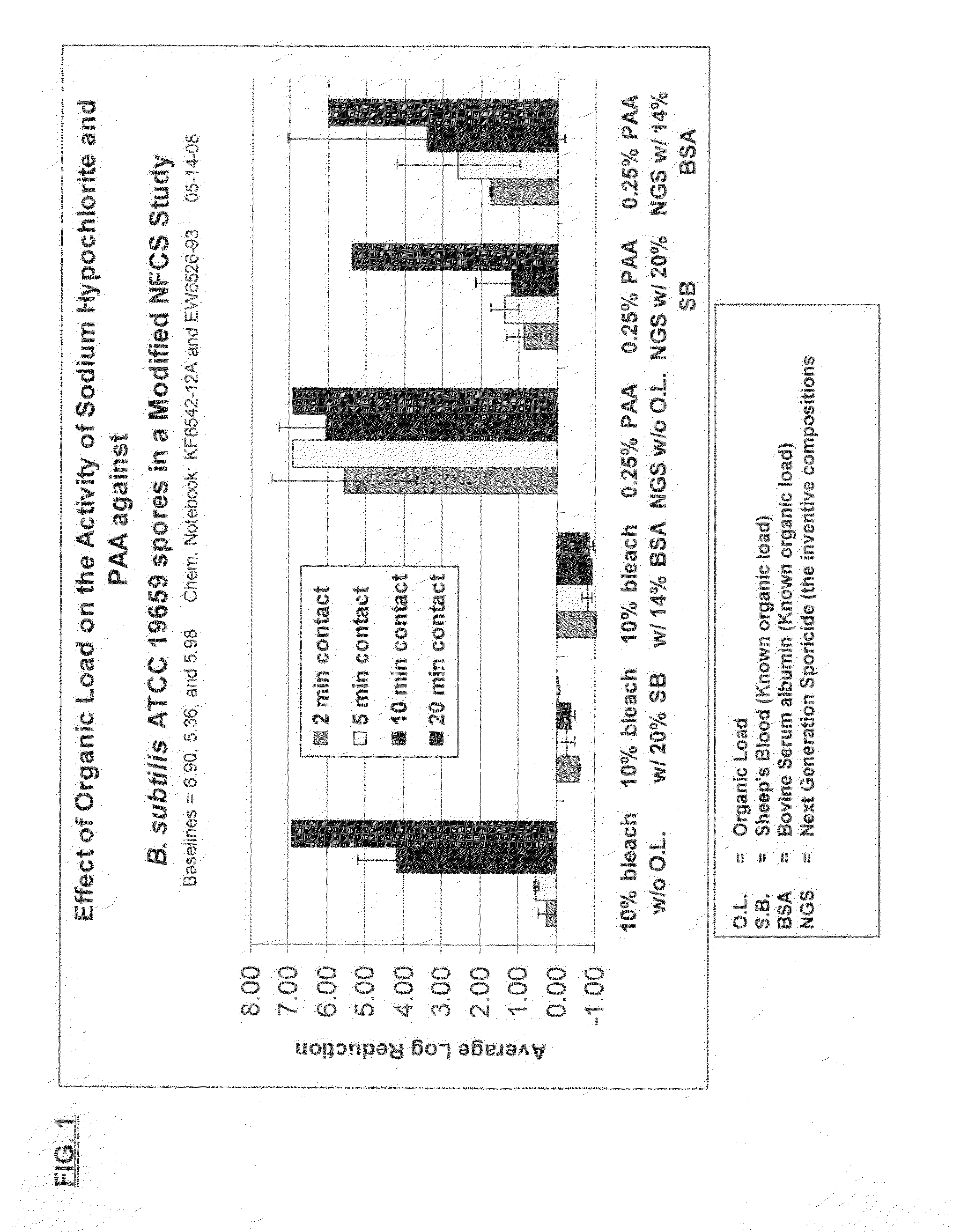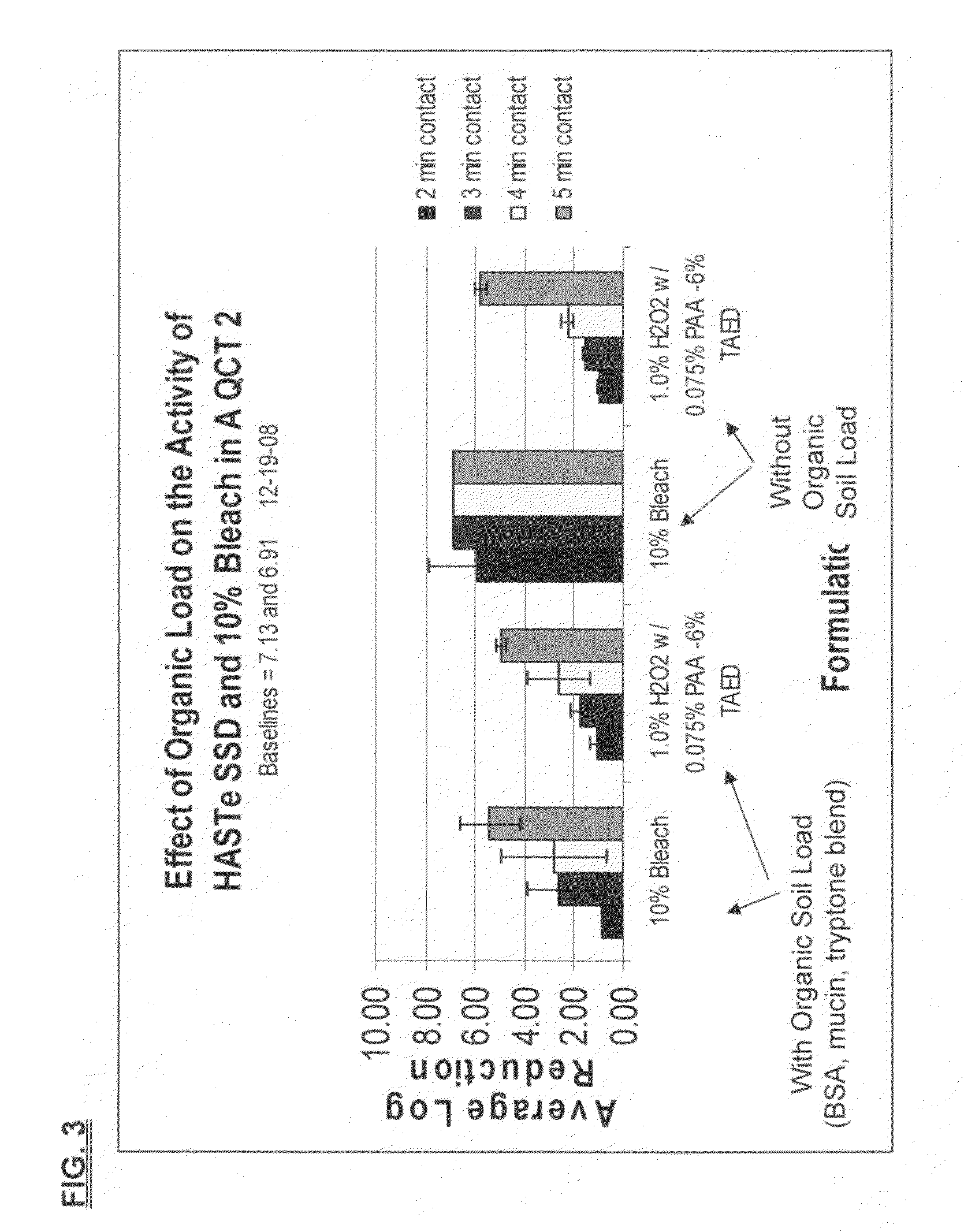Low odor, hard surface sporicides and chemical decontaminants
a technology of hard surface sporicides and chemical decontaminants, applied in the direction of biocide, ammonia active ingredients, detergent compounding agents, etc., can solve the problems of inherently difficult to destroy, aesthetic and handling disadvantages, and inability to easily contaminate the surface, etc., to achieve rapid generation of peracetic acid, the effect of being convenient to handle and transpor
- Summary
- Abstract
- Description
- Claims
- Application Information
AI Technical Summary
Benefits of technology
Problems solved by technology
Method used
Image
Examples
example 1
[0105]Sporicidal efficacy of the two-part liquid activator / formulated hydrogen peroxide system in a modified Non-Food Contact Sanitizer (NFCS) study is shown in FIG. 1. The results show that the inventive formulation, which generated approximately 0.25% peracetic acid, was superior to bleach (1:10 dilution in water) against Bacillus subtilis, a known spore former, in the presence of various organic loads and varying contact times. Bacillus subtilis, ATCC 19659 is useful as a surrogate for spore forming bacteria, such as anthrax, among others.
example 2
[0106]Sporicidal efficacy of the inventive compositions was tested, using the Quantitative Carrier Test 2 (QCT-2) method against C. diff spores. The inventive composition shown in Table VII, below, was tested at various concentrations and mixed as indicated below.
TABLE VIIDry TAED ActivatorAmountIngredientFunction(wt. %)TetraacetylethylenediamineActive Ingredient63.58%(TAED)Alkyldiphenyl Oxide DisulfonateAnionic Surfactant / 11.49%(Dowfax C10L - 45% active (aq))DispersantTetrasodium IminodisuccinateChelating Agent / 22.26%Alkalinity SourceSodium CarbonateAlkalinity Source / Buffer2.67%Formulated Liquid Hydrogen PeroxideIngredientFunctionConcentration35% HydrogenActive Ingredient2.86%Peroxide (aq)Deionized Water—96.79%Poloxamer 407Nonionic Surfactant0.05%FragranceFragrance0.30%
Dilutions:
[0107]To generate 0.050% peracetic acid, 0.225 grams of the dry TAED activator was added to 200 mL of the formulated hydrogen peroxide.
To generate 0.075% peracetic acid, 0.337 grams of the dry TAED ...
example 3
Effect of Soil Load
[0109]The effect of organic soil load on average log reduction using QCT-2 testing was also evaluated. The formulation used is set forth in Table VIII below.
TABLE VIIIDry TAED ActivatorIngredientFunctionAmountTetraacetylethylene-Active Ingredient0.2757 gramsdiamine (TAED)Alkyldiphenyl OxideAnionic Surfactant / 0.0498 gramsDisulfonate (DowfaxDispersantC10L - 45% active(aq))TetrasodiumChelating Agent / 0.1107 gramsIminodisuccinateAlkalinity SourceSodium CarbonateAlkalinity Source / 0.0133 gramsBufferPolyvinyl AlcoholFilm Material0.0792 gramsFilm**PVA film was added to have the powder in a PVA water-solublepouch that dissolves upon “activation.” Studies have shown ithad no impact on efficacy or peracetic acid generation. Formulated Liquid Hydrogen PeroxideIngredientFunctionConcentration (wt. %)35% Hydrogen PeroxideActive Ingredient2.86%(aq)Deionized Water—96.79%Poloxamer 407Nonionic Surfactant0.05%FragranceFragrance0.30%The above powder composition was added to 200 mL of t...
PUM
| Property | Measurement | Unit |
|---|---|---|
| alkalinity | aaaaa | aaaaa |
| composition | aaaaa | aaaaa |
| concentration | aaaaa | aaaaa |
Abstract
Description
Claims
Application Information
 Login to View More
Login to View More - R&D
- Intellectual Property
- Life Sciences
- Materials
- Tech Scout
- Unparalleled Data Quality
- Higher Quality Content
- 60% Fewer Hallucinations
Browse by: Latest US Patents, China's latest patents, Technical Efficacy Thesaurus, Application Domain, Technology Topic, Popular Technical Reports.
© 2025 PatSnap. All rights reserved.Legal|Privacy policy|Modern Slavery Act Transparency Statement|Sitemap|About US| Contact US: help@patsnap.com



